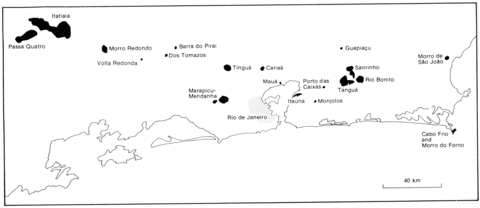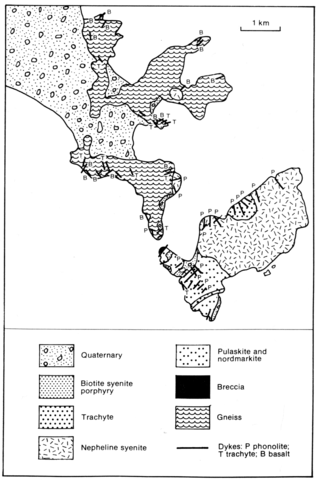stripes
This is an area of alkaline rocks which includes much of the island of Cabo Frio (6.3 km2) together with the smaller intrusions of Morro do Forno and Atalaia on the adjacent mainland; there is an abundant dyke suite. The country rocks are Precambrian migmatites and sillimanite and biotite gneisses. Alkaline rocks include nepheline syenite, foyaite, pulaskite, nordmarkite, phonolite, trachyte, nepheline syenite aplite and lamprophyres. The nepheline syenites are variably granular or trachytic-textured rocks of orthoclase, oligoclase, nepheline, altered to cancrinite and zeolites, interstitial sodalite, augite/aegirine-augite, arfvedsonite and riebeckite with accessory wairakite, woehlerite, zircon, sphene, titanian magnetite, pyrite and biotite. The nordmarkites and pulaskites have similar mafic mineralogies but the former contain some quartz. A biotite syenite porphyry includes biotite phenocrysts up to 5 cm and amphiboles to 2 cm. The Atalaia intrusion comprises a nepheline syenite similar to umptekite. Trachytes are essentially sanidine-aegirine rocks, while phonolites include sanidine, nepheline and aegirine-augite as phenocrysts together with analcime, fluorite, zeolites, cancrinite, (?)eudialyte, zircon, amphibole and magnetite. Some trachyte and phonolite dykes up to 40 cm thick contain orbicular structures. Monchiquites and limburgites also occur and basalt dykes up to 50 m thick are widespread on the mainland. Magmatic breccias occurring at the south end of Cabo Frio cut gneisses and are separated from pulaskites and nordmarkites by a 15 m thick trachyte dyke. Blocks of gneiss, trachyte and phonolite a metre or more in diameter are present in the breccias.
AMARAL, G., BUSHEE, J., CORDANI, U.G., KAWASHITA, K. and REYNOLDS, J.H. 1967. Potassium-argon ages of alkaline rocks from southern Brazil. Geochimica et Cosmochimica Acta, 31: 117-42.
BUSHEE, J.M. 1974. Potassium-argon ages of some alkaline rocks from southern Brazil.Thesis (unpublished), University of California, Berkeley. 145 pp.
Lima, 1974 and 1976;
VALENCA, J.G. and KLEIN, V.C. 1984. Complexos alcalinos situados a leste da Baia de Guanabara, Rio de Janeiro. Anais Congresso Brasileiro de Geologia, 33: 5317-33


